Leadership and Decision Making Case Study Analysis: Foreign Auto Shop
VerifiedAdded on 2020/03/04
|7
|1365
|1567
Case Study
AI Summary
This case study analyzes the leadership and decision-making of Alan, the leader of a foreign auto repair shop, in two distinct scenarios. Part 1 examines Alan's typical leadership style, which is characterized as participative, focusing on employee development, motivation, and empowerment. The analysis highlights how Alan's approach aligns with the G2 decision-making model, encouraging employee input and consensus-building. The study considers the situational leadership style needed for a younger employee named Kirk, who lacks experience and motivation. Part 2 shifts to a crisis situation, a flood, where Alan adapts his leadership to an authoritarian style, issuing direct orders to protect the shop's assets. Despite the change, the analysis emphasizes Alan's ability to remain open to suggestions and support his team, demonstrating the effectiveness of adapting leadership styles to the situation. The case study references several academic sources to support the analysis of leadership behaviors and their impact on the auto shop's environment.
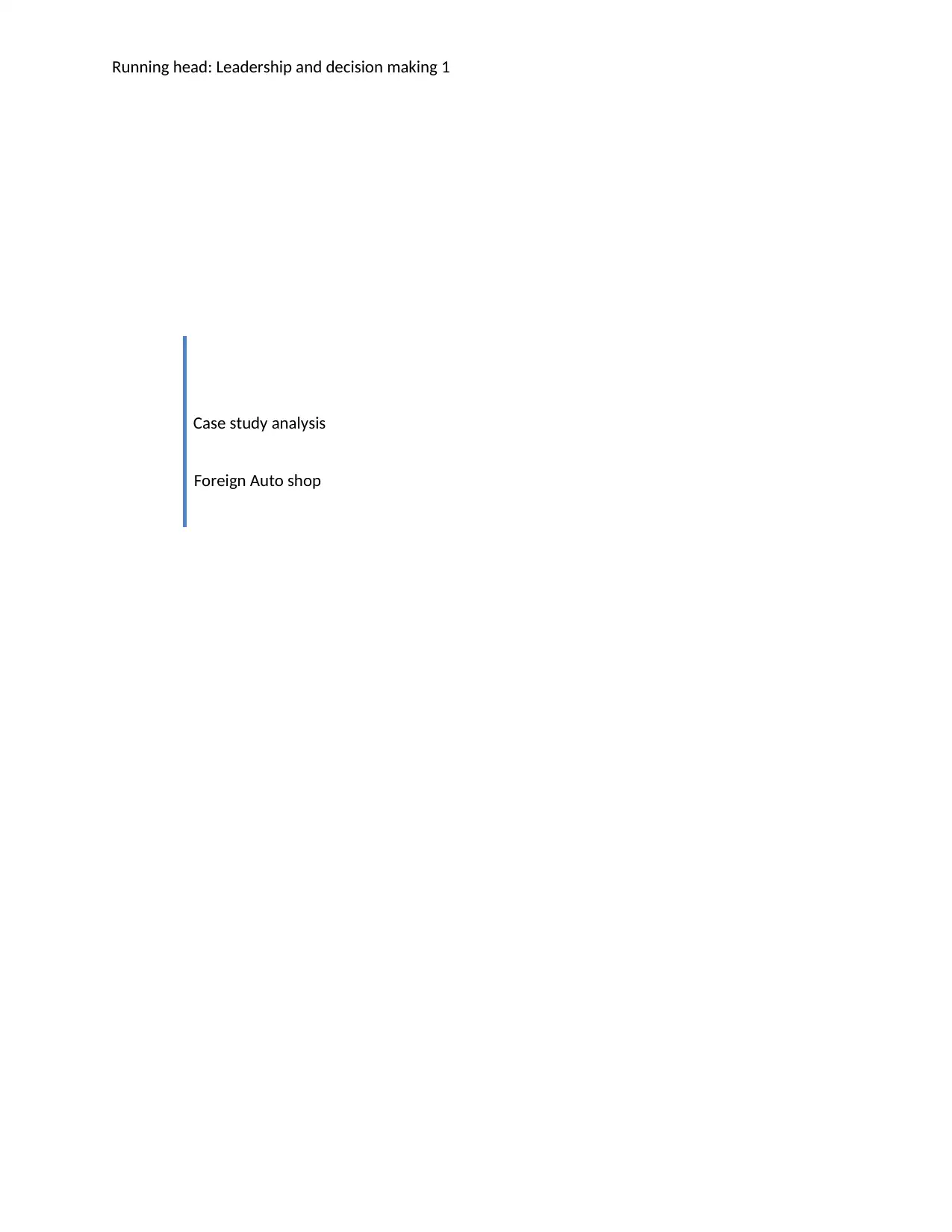
Running head: Leadership and decision making 1
Case study analysis
Foreign Auto shop
Case study analysis
Foreign Auto shop
Paraphrase This Document
Need a fresh take? Get an instant paraphrase of this document with our AI Paraphraser
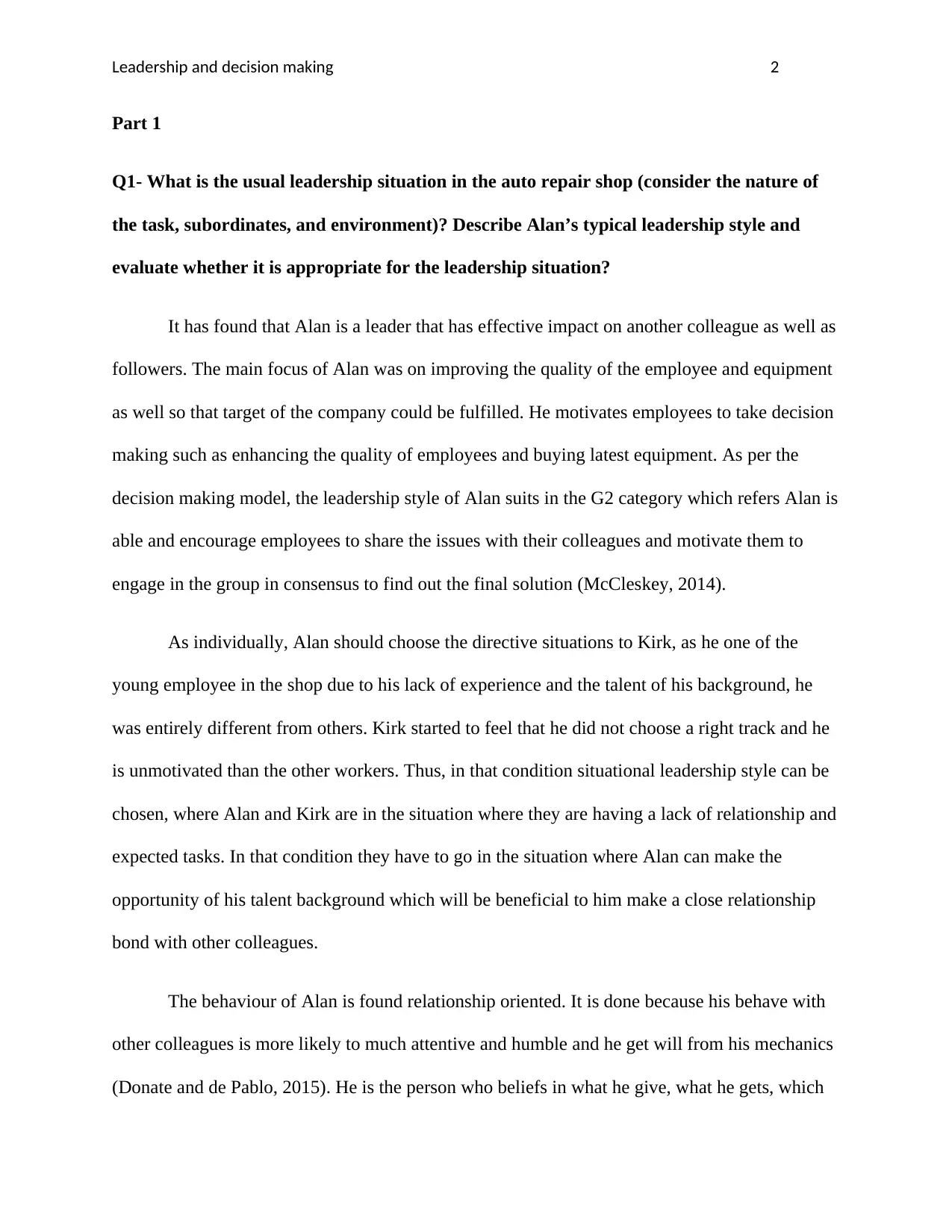
Leadership and decision making 2
Part 1
Q1- What is the usual leadership situation in the auto repair shop (consider the nature of
the task, subordinates, and environment)? Describe Alan’s typical leadership style and
evaluate whether it is appropriate for the leadership situation?
It has found that Alan is a leader that has effective impact on another colleague as well as
followers. The main focus of Alan was on improving the quality of the employee and equipment
as well so that target of the company could be fulfilled. He motivates employees to take decision
making such as enhancing the quality of employees and buying latest equipment. As per the
decision making model, the leadership style of Alan suits in the G2 category which refers Alan is
able and encourage employees to share the issues with their colleagues and motivate them to
engage in the group in consensus to find out the final solution (McCleskey, 2014).
As individually, Alan should choose the directive situations to Kirk, as he one of the
young employee in the shop due to his lack of experience and the talent of his background, he
was entirely different from others. Kirk started to feel that he did not choose a right track and he
is unmotivated than the other workers. Thus, in that condition situational leadership style can be
chosen, where Alan and Kirk are in the situation where they are having a lack of relationship and
expected tasks. In that condition they have to go in the situation where Alan can make the
opportunity of his talent background which will be beneficial to him make a close relationship
bond with other colleagues.
The behaviour of Alan is found relationship oriented. It is done because his behave with
other colleagues is more likely to much attentive and humble and he get will from his mechanics
(Donate and de Pablo, 2015). He is the person who beliefs in what he give, what he gets, which
Part 1
Q1- What is the usual leadership situation in the auto repair shop (consider the nature of
the task, subordinates, and environment)? Describe Alan’s typical leadership style and
evaluate whether it is appropriate for the leadership situation?
It has found that Alan is a leader that has effective impact on another colleague as well as
followers. The main focus of Alan was on improving the quality of the employee and equipment
as well so that target of the company could be fulfilled. He motivates employees to take decision
making such as enhancing the quality of employees and buying latest equipment. As per the
decision making model, the leadership style of Alan suits in the G2 category which refers Alan is
able and encourage employees to share the issues with their colleagues and motivate them to
engage in the group in consensus to find out the final solution (McCleskey, 2014).
As individually, Alan should choose the directive situations to Kirk, as he one of the
young employee in the shop due to his lack of experience and the talent of his background, he
was entirely different from others. Kirk started to feel that he did not choose a right track and he
is unmotivated than the other workers. Thus, in that condition situational leadership style can be
chosen, where Alan and Kirk are in the situation where they are having a lack of relationship and
expected tasks. In that condition they have to go in the situation where Alan can make the
opportunity of his talent background which will be beneficial to him make a close relationship
bond with other colleagues.
The behaviour of Alan is found relationship oriented. It is done because his behave with
other colleagues is more likely to much attentive and humble and he get will from his mechanics
(Donate and de Pablo, 2015). He is the person who beliefs in what he give, what he gets, which
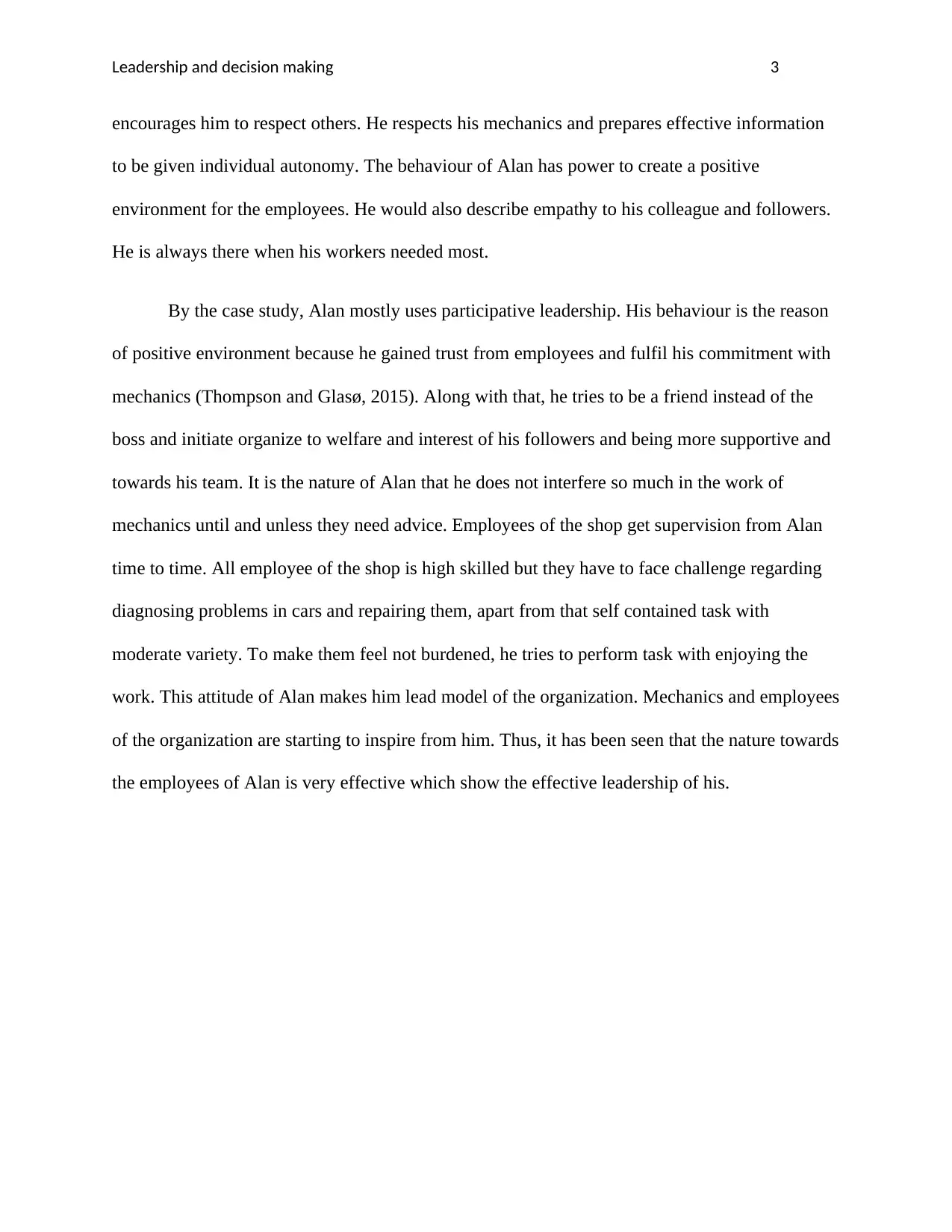
Leadership and decision making 3
encourages him to respect others. He respects his mechanics and prepares effective information
to be given individual autonomy. The behaviour of Alan has power to create a positive
environment for the employees. He would also describe empathy to his colleague and followers.
He is always there when his workers needed most.
By the case study, Alan mostly uses participative leadership. His behaviour is the reason
of positive environment because he gained trust from employees and fulfil his commitment with
mechanics (Thompson and Glasø, 2015). Along with that, he tries to be a friend instead of the
boss and initiate organize to welfare and interest of his followers and being more supportive and
towards his team. It is the nature of Alan that he does not interfere so much in the work of
mechanics until and unless they need advice. Employees of the shop get supervision from Alan
time to time. All employee of the shop is high skilled but they have to face challenge regarding
diagnosing problems in cars and repairing them, apart from that self contained task with
moderate variety. To make them feel not burdened, he tries to perform task with enjoying the
work. This attitude of Alan makes him lead model of the organization. Mechanics and employees
of the organization are starting to inspire from him. Thus, it has been seen that the nature towards
the employees of Alan is very effective which show the effective leadership of his.
encourages him to respect others. He respects his mechanics and prepares effective information
to be given individual autonomy. The behaviour of Alan has power to create a positive
environment for the employees. He would also describe empathy to his colleague and followers.
He is always there when his workers needed most.
By the case study, Alan mostly uses participative leadership. His behaviour is the reason
of positive environment because he gained trust from employees and fulfil his commitment with
mechanics (Thompson and Glasø, 2015). Along with that, he tries to be a friend instead of the
boss and initiate organize to welfare and interest of his followers and being more supportive and
towards his team. It is the nature of Alan that he does not interfere so much in the work of
mechanics until and unless they need advice. Employees of the shop get supervision from Alan
time to time. All employee of the shop is high skilled but they have to face challenge regarding
diagnosing problems in cars and repairing them, apart from that self contained task with
moderate variety. To make them feel not burdened, he tries to perform task with enjoying the
work. This attitude of Alan makes him lead model of the organization. Mechanics and employees
of the organization are starting to inspire from him. Thus, it has been seen that the nature towards
the employees of Alan is very effective which show the effective leadership of his.
⊘ This is a preview!⊘
Do you want full access?
Subscribe today to unlock all pages.

Trusted by 1+ million students worldwide
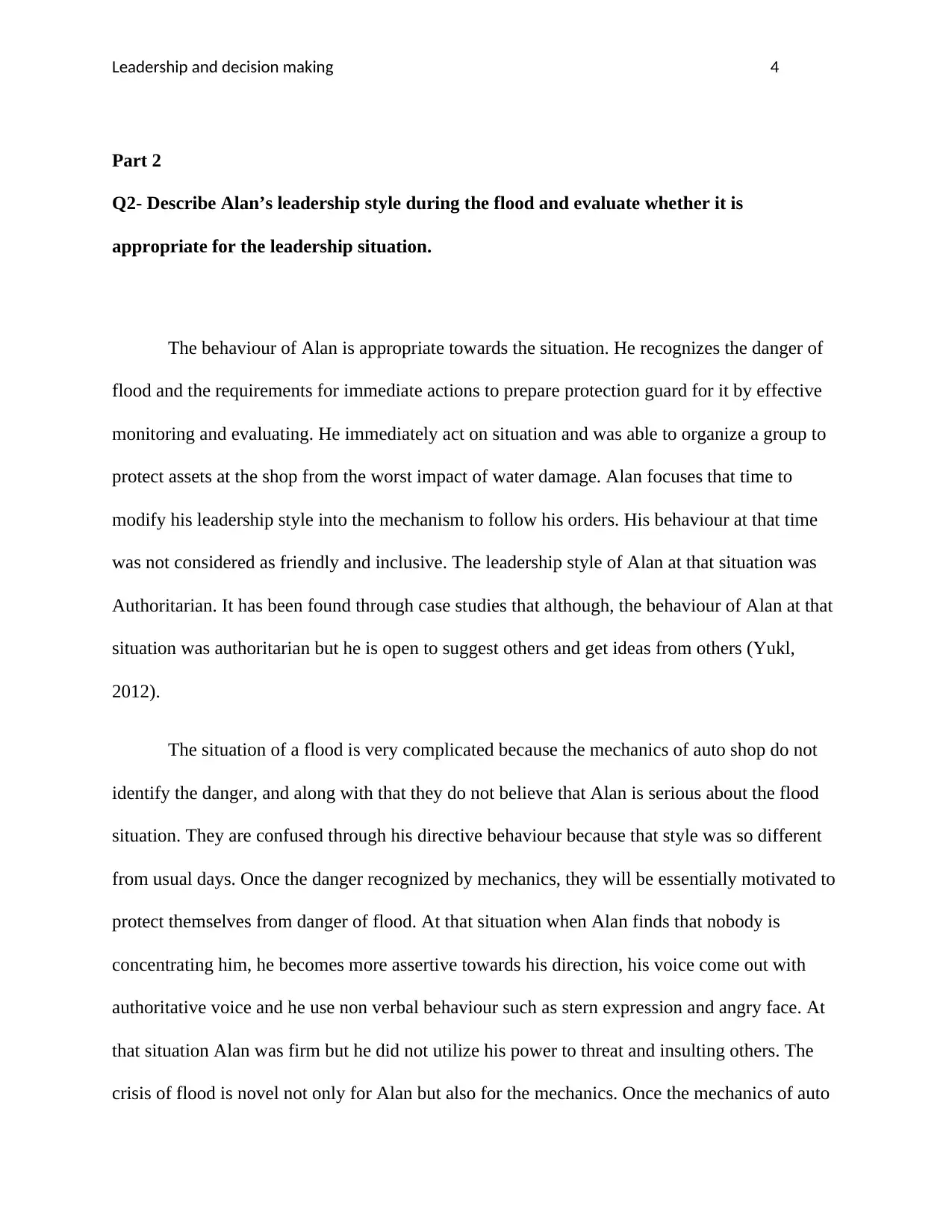
Leadership and decision making 4
Part 2
Q2- Describe Alan’s leadership style during the flood and evaluate whether it is
appropriate for the leadership situation.
The behaviour of Alan is appropriate towards the situation. He recognizes the danger of
flood and the requirements for immediate actions to prepare protection guard for it by effective
monitoring and evaluating. He immediately act on situation and was able to organize a group to
protect assets at the shop from the worst impact of water damage. Alan focuses that time to
modify his leadership style into the mechanism to follow his orders. His behaviour at that time
was not considered as friendly and inclusive. The leadership style of Alan at that situation was
Authoritarian. It has been found through case studies that although, the behaviour of Alan at that
situation was authoritarian but he is open to suggest others and get ideas from others (Yukl,
2012).
The situation of a flood is very complicated because the mechanics of auto shop do not
identify the danger, and along with that they do not believe that Alan is serious about the flood
situation. They are confused through his directive behaviour because that style was so different
from usual days. Once the danger recognized by mechanics, they will be essentially motivated to
protect themselves from danger of flood. At that situation when Alan finds that nobody is
concentrating him, he becomes more assertive towards his direction, his voice come out with
authoritative voice and he use non verbal behaviour such as stern expression and angry face. At
that situation Alan was firm but he did not utilize his power to threat and insulting others. The
crisis of flood is novel not only for Alan but also for the mechanics. Once the mechanics of auto
Part 2
Q2- Describe Alan’s leadership style during the flood and evaluate whether it is
appropriate for the leadership situation.
The behaviour of Alan is appropriate towards the situation. He recognizes the danger of
flood and the requirements for immediate actions to prepare protection guard for it by effective
monitoring and evaluating. He immediately act on situation and was able to organize a group to
protect assets at the shop from the worst impact of water damage. Alan focuses that time to
modify his leadership style into the mechanism to follow his orders. His behaviour at that time
was not considered as friendly and inclusive. The leadership style of Alan at that situation was
Authoritarian. It has been found through case studies that although, the behaviour of Alan at that
situation was authoritarian but he is open to suggest others and get ideas from others (Yukl,
2012).
The situation of a flood is very complicated because the mechanics of auto shop do not
identify the danger, and along with that they do not believe that Alan is serious about the flood
situation. They are confused through his directive behaviour because that style was so different
from usual days. Once the danger recognized by mechanics, they will be essentially motivated to
protect themselves from danger of flood. At that situation when Alan finds that nobody is
concentrating him, he becomes more assertive towards his direction, his voice come out with
authoritative voice and he use non verbal behaviour such as stern expression and angry face. At
that situation Alan was firm but he did not utilize his power to threat and insulting others. The
crisis of flood is novel not only for Alan but also for the mechanics. Once the mechanics of auto
Paraphrase This Document
Need a fresh take? Get an instant paraphrase of this document with our AI Paraphraser
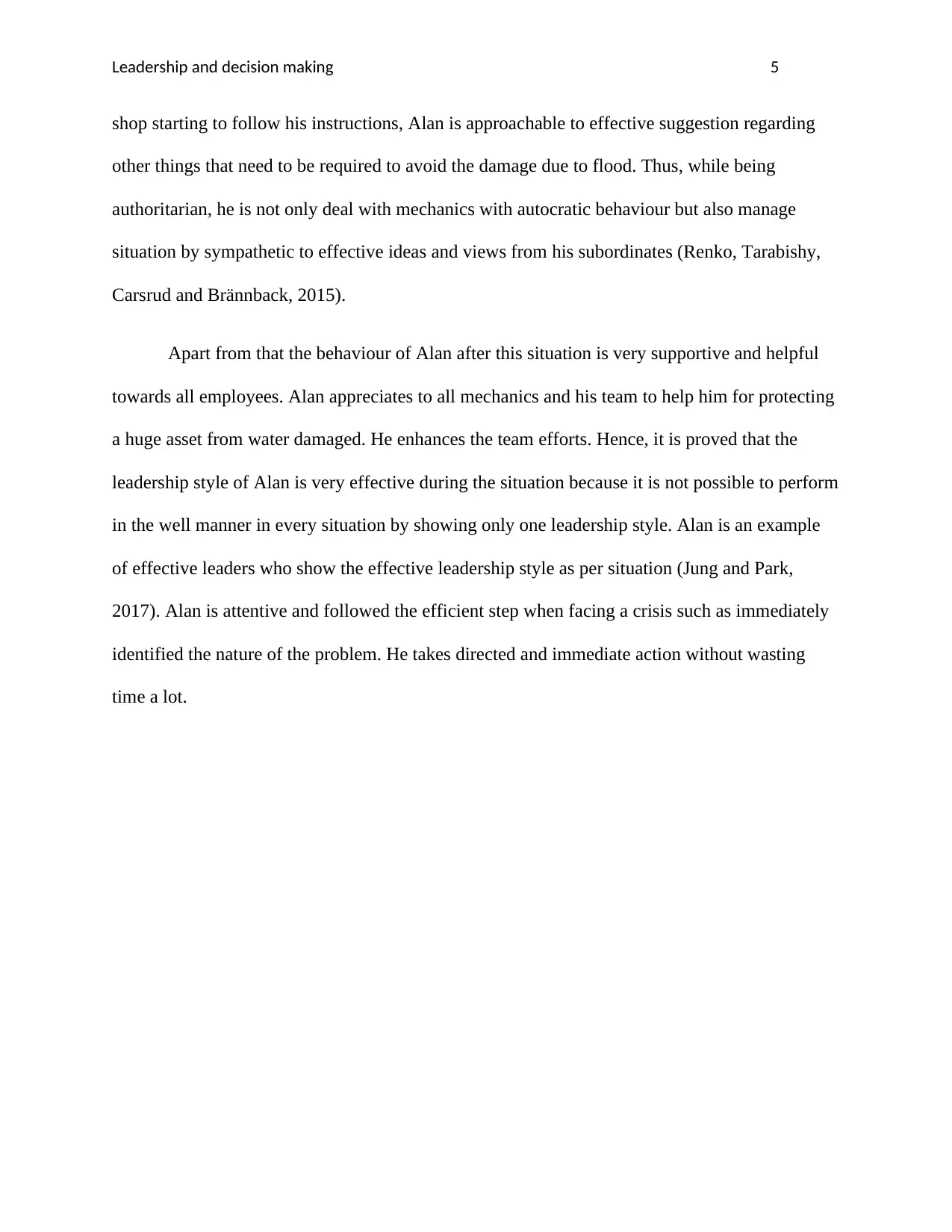
Leadership and decision making 5
shop starting to follow his instructions, Alan is approachable to effective suggestion regarding
other things that need to be required to avoid the damage due to flood. Thus, while being
authoritarian, he is not only deal with mechanics with autocratic behaviour but also manage
situation by sympathetic to effective ideas and views from his subordinates (Renko, Tarabishy,
Carsrud and Brännback, 2015).
Apart from that the behaviour of Alan after this situation is very supportive and helpful
towards all employees. Alan appreciates to all mechanics and his team to help him for protecting
a huge asset from water damaged. He enhances the team efforts. Hence, it is proved that the
leadership style of Alan is very effective during the situation because it is not possible to perform
in the well manner in every situation by showing only one leadership style. Alan is an example
of effective leaders who show the effective leadership style as per situation (Jung and Park,
2017). Alan is attentive and followed the efficient step when facing a crisis such as immediately
identified the nature of the problem. He takes directed and immediate action without wasting
time a lot.
shop starting to follow his instructions, Alan is approachable to effective suggestion regarding
other things that need to be required to avoid the damage due to flood. Thus, while being
authoritarian, he is not only deal with mechanics with autocratic behaviour but also manage
situation by sympathetic to effective ideas and views from his subordinates (Renko, Tarabishy,
Carsrud and Brännback, 2015).
Apart from that the behaviour of Alan after this situation is very supportive and helpful
towards all employees. Alan appreciates to all mechanics and his team to help him for protecting
a huge asset from water damaged. He enhances the team efforts. Hence, it is proved that the
leadership style of Alan is very effective during the situation because it is not possible to perform
in the well manner in every situation by showing only one leadership style. Alan is an example
of effective leaders who show the effective leadership style as per situation (Jung and Park,
2017). Alan is attentive and followed the efficient step when facing a crisis such as immediately
identified the nature of the problem. He takes directed and immediate action without wasting
time a lot.
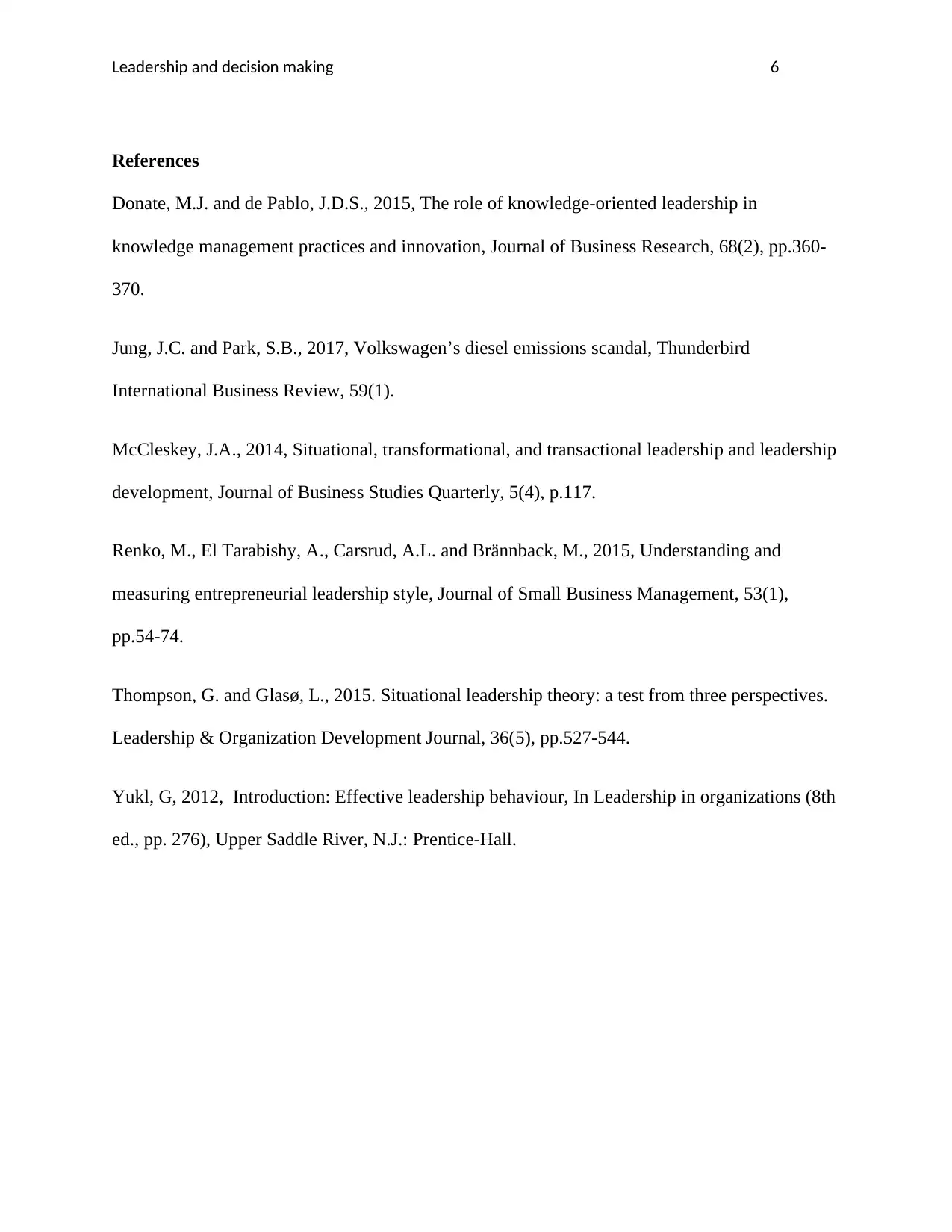
Leadership and decision making 6
References
Donate, M.J. and de Pablo, J.D.S., 2015, The role of knowledge-oriented leadership in
knowledge management practices and innovation, Journal of Business Research, 68(2), pp.360-
370.
Jung, J.C. and Park, S.B., 2017, Volkswagen’s diesel emissions scandal, Thunderbird
International Business Review, 59(1).
McCleskey, J.A., 2014, Situational, transformational, and transactional leadership and leadership
development, Journal of Business Studies Quarterly, 5(4), p.117.
Renko, M., El Tarabishy, A., Carsrud, A.L. and Brännback, M., 2015, Understanding and
measuring entrepreneurial leadership style, Journal of Small Business Management, 53(1),
pp.54-74.
Thompson, G. and Glasø, L., 2015. Situational leadership theory: a test from three perspectives.
Leadership & Organization Development Journal, 36(5), pp.527-544.
Yukl, G, 2012, Introduction: Effective leadership behaviour, In Leadership in organizations (8th
ed., pp. 276), Upper Saddle River, N.J.: Prentice-Hall.
References
Donate, M.J. and de Pablo, J.D.S., 2015, The role of knowledge-oriented leadership in
knowledge management practices and innovation, Journal of Business Research, 68(2), pp.360-
370.
Jung, J.C. and Park, S.B., 2017, Volkswagen’s diesel emissions scandal, Thunderbird
International Business Review, 59(1).
McCleskey, J.A., 2014, Situational, transformational, and transactional leadership and leadership
development, Journal of Business Studies Quarterly, 5(4), p.117.
Renko, M., El Tarabishy, A., Carsrud, A.L. and Brännback, M., 2015, Understanding and
measuring entrepreneurial leadership style, Journal of Small Business Management, 53(1),
pp.54-74.
Thompson, G. and Glasø, L., 2015. Situational leadership theory: a test from three perspectives.
Leadership & Organization Development Journal, 36(5), pp.527-544.
Yukl, G, 2012, Introduction: Effective leadership behaviour, In Leadership in organizations (8th
ed., pp. 276), Upper Saddle River, N.J.: Prentice-Hall.
⊘ This is a preview!⊘
Do you want full access?
Subscribe today to unlock all pages.

Trusted by 1+ million students worldwide

Leadership and decision making 7
1 out of 7
Related Documents
Your All-in-One AI-Powered Toolkit for Academic Success.
+13062052269
info@desklib.com
Available 24*7 on WhatsApp / Email
![[object Object]](/_next/static/media/star-bottom.7253800d.svg)
Unlock your academic potential
Copyright © 2020–2025 A2Z Services. All Rights Reserved. Developed and managed by ZUCOL.




